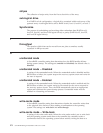
stripes
The collection of stripe units, from the first to last drive of the array.
sub-logical drive
In a RAID level-x0 configuration, a logical drive contained within each array of the
spanned array. A sub-logical drive can be RAID level-0, level-1, level-1E, or level 5.
Synchronize
The process of recalculating and rewriting either redundant data (RAID level-1,
level-1E, level-10, and level-1E0 logical drives) or parity (RAID level-5, level-5E,
and level-50 logical drives).
T
throughput
The speed at which data can be moved from one place to another, usually
expressed in MB per second.
U
unattended mode
A ServeRAID controller setting that determines how the BIOS handles failures
during system startup. The settings are enabled and disabled; the default value is
disabled.
unattended mode -- Disabled
A setting of the unattended mode. When the unattended mode is disabled and the
BIOS detects a failure, the system stops at the recovery option screen and waits for
the user to respond.
unattended mode -- Enabled
A setting of the unattended mode. When the unattended mode is enabled and the
BIOS detects a failure, the system waits for 30 seconds for the user to respond to
the recovery options screen. Then, the BIOS automatically selects an appropriate
option and continues the system startup process. Unattended mode must be
enabled in a clustering environment.
W
write-cache mode
A ServeRAID controller setting that determines whether the controller writes data
to the physical drive before or after sending a confirmation to the operating
system. The settings are write back and write through.
write-cache mode -- Write-back
A setting of the write-cache mode. When the write-cache mode is set to write back
and the operating system sends data to the controller, the controller sends a
confirmation back to the operating system before actually writing the data to a
272 ServeRAID Manager Installation and User's Guide


















